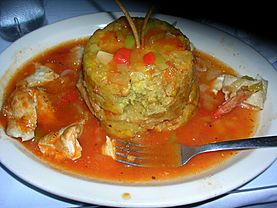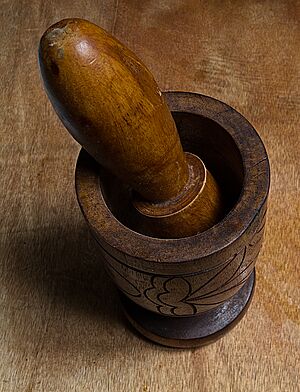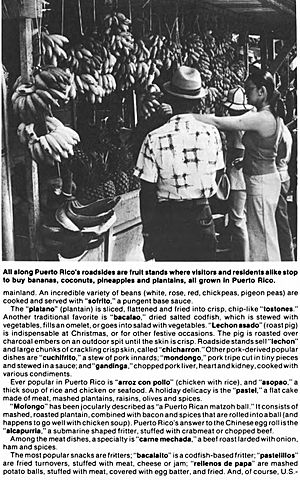Mofongo facts for kids

Mofongo
|
|
| Course | Main course |
|---|---|
| Place of origin | |
| Serving temperature | Hot |
| Main ingredients | Plantains, chicharrón, olive oil, and garlic |
| Variations | Fufu, Tacacho, Cayeye, Mangú |
| Other information | Popular throughout: Puerto Rico Dominican Republic New Jersey Florida New York City Boston Colombia |
Mofongo is a popular dish from Puerto Rico. It's mainly made from fried plantains. Green plantains are fried, then mashed in a special wooden bowl called a pilón. They add salt, garlic, broth, and olive oil. The mashed plantains form a tight ball, often with crunchy pork cracklings (called chicharrón) or bacon inside. People usually eat Mofongo with fried meat and a side of chicken broth soup. Sometimes, it's made with vegetables, chicken, shrimp, beef, or even octopus inside.
Contents
Where Did Mofongo Come From?
Mofongo's history connects to a West African dish called fufu. It also has influences from Spanish and Taíno cultures. Fufu is made from starchy vegetables. Africans brought this dish to the Caribbean during the time of slavery. You can find similar dishes in other places like Cuba (fufu de plátano), the Dominican Republic (mangú), and Colombia (cayeye).
The first time Mofongo appeared in a Puerto Rican cookbook was in 1859. The book was called El Cocinero Puertorriqueño.
People in Puerto Rico used a special tool, like a mallet, to mash large amounts of starchy foods. Then, they would soften the mashed food with liquids and fats. The name "mofongo" comes from the Kikongo word mfwenge-mfwenge. This word means "a great amount of nothing at all."
Mofongo and Puerto Rican Culture
Mofongo developed from the African fufu, but it used plants found in the Caribbean. Plantains are the most common ingredient. However, other starchy roots native to the island, used by the Taíno people, can also be used. Puerto Ricans love fried foods, which are sometimes called cuchifrito in New York City.
Spanish ingredients like pork, garlic, broth, and olive oil are common in Puerto Rican cuisine. You can find them in many traditional dishes. The method of frying comes from African traditions and is used a lot in Caribbean cooking. Broth for Mofongo is often made with chicken and sofrito. Sofrito is a mix of Spanish and Taíno fruits, vegetables, and herbs.
How to Make Mofongo
First, plantains or other starchy roots are cut into thick pieces. Then, they are deep-fried until they are crispy outside but soft inside. After frying, the plantains are mashed in a wooden mortar and pestle called a pilón. These pilones are often made from strong native woods like mahogany. Broth, olive oil, garlic, and pork cracklings are added and mashed together. Mofongo is usually much firmer than fufu.
In Africa, fufu is often served with a bowl of soup. In Puerto Rico, Mofongo traditionally comes with chicken broth soup. However, eating it with braised (slow-cooked) meat has become more common.
Different Kinds of Mofongo
In Puerto Rico, people also make Mofongo with other ingredients. Some popular variations include:
- Mofongo de yuca: Made with cassava.
- Mofongo de pana: Made with breadfruit.
- Trifongo: A mix of breadfruit or cassava with both ripe and green plantains.
- Bifongo or mofongo de amarillo: Made with both ripe and green plantains.
When Mofongo is stuffed with shrimp (camarón in Spanish), it's called camarofongo.
Thanksgiving is a holiday that Puerto Ricans celebrate. On Thanksgiving, turkey is often stuffed with bread. Sometimes, Mofongo is mixed with the bread stuffing or used instead of it. This dish is called pavochon.
Mofongo relleno means "stuffed Mofongo." This version was first made in a restaurant on the west coast of Puerto Rico. Seafood, which is plentiful there, was placed inside the plantain ball. Sometimes, braised meat or more seafood is poured over it. Today, mofongo relleno is often stuffed with seafood, chicken, or other meats.
The company Frito-Lay makes a snack called MoFongo Snax. It's a bag that combines plantain chips, cassava chips, and pork rinds.
Mofongo Around the World
In the 1960s, many Dominicans moved to Puerto Rico and New York City. They were trying to escape a difficult time in the Dominican Republic. Mofongo quickly became popular with Dominicans living in these areas. It is now a main dish in many Dominican restaurants. In Moca, Dominican Republic, they are known for adding Cheddar cheese to their Mofongo.
A similar dish called Bolón de verde is found in Ecuador. This dish appeared later in Ecuadorian cooking. It uses boiled or roasted plantains mashed with chicharrón and cheese. These are then formed into balls and fried.
Mofongo has become popular among Colombians, Cubans, and Dominicans living in the United States. It's also popular wherever many Puerto Ricans or Dominicans live.
You can now find Mofongo in fancy Latin restaurants. It's often served alongside dishes from other Latin American countries. For example, it might be served with Peruvian ceviche, South American churrasco, Cuban ropa vieja, or Mexican salsa verde.
See also
 In Spanish: Fufú de plátano verde para niños
In Spanish: Fufú de plátano verde para niños





